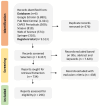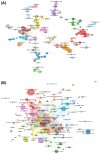Use of CRISPR Technology in Gene Editing for Tolerance to Biotic Factors in Plants: A Systematic Review
- PMID: 39451539
- PMCID: PMC11505962
- DOI: 10.3390/cimb46100659
Use of CRISPR Technology in Gene Editing for Tolerance to Biotic Factors in Plants: A Systematic Review
Abstract
The objective of this systematic review (SR) was to select studies on the use of gene editing by CRISPR technology related to plant resistance to biotic stresses. We sought to evaluate articles deposited in six electronic databases, using pre-defined inclusion and exclusion criteria. This SR demonstrates that countries such as China and the United States of America stand out in studies with CRISPR/Cas. Among the most studied crops are rice, tomatoes and the model plant Arabidopsis thaliana. The most cited biotic agents include the genera, Xanthomonas, Manaporthe, Pseudomonas and Phytophthora. This SR also identifies several CRISPR/Cas-edited genes and demonstrates that plant responses to stressors are mediated by many complex signaling pathways. The Cas9 enzyme is used in most articles and Cas12 and 13 are used as additional editing tools. Furthermore, the quality of the articles included in this SR was validated by a risk of bias analysis. The information collected in this SR helps to understand the state of the art of CRISPR/Cas aimed at improving resistance to diseases and pests to understand the mechanisms involved in most host-pathogen relationships. This SR shows that the CRISPR/Cas system provides a straightforward method for rapid gene targeting, providing useful information for plant breeding programs.
Keywords: CRISPR/Cas; biotic stress; pests; phytopathogens; plant diseases; plant genetic improvement.
Conflict of interest statement
The authors declare no conflicts of interest.
Figures










Similar articles
-
Gene Editing for Plant Resistance to Abiotic Factors: A Systematic Review.Plants (Basel). 2023 Jan 9;12(2):305. doi: 10.3390/plants12020305. Plants (Basel). 2023. PMID: 36679018 Free PMC article. Review.
-
Application of CRISPR/Cas system in cereal improvement for biotic and abiotic stress tolerance.Planta. 2022 Nov 3;256(6):106. doi: 10.1007/s00425-022-04023-w. Planta. 2022. PMID: 36326904 Review.
-
CRISPR/Cas Genome Editing Technologies for Plant Improvement against Biotic and Abiotic Stresses: Advances, Limitations, and Future Perspectives.Cells. 2022 Dec 5;11(23):3928. doi: 10.3390/cells11233928. Cells. 2022. PMID: 36497186 Free PMC article. Review.
-
[Improvement of Crops Using the CRISPR/Cas System: New Target Genes].Mol Biol (Mosk). 2023 May-Jun;57(3):387-410. Mol Biol (Mosk). 2023. PMID: 37326044 Review. Russian.
-
Modern Trends in Plant Genome Editing: An Inclusive Review of the CRISPR/Cas9 Toolbox.Int J Mol Sci. 2019 Aug 19;20(16):4045. doi: 10.3390/ijms20164045. Int J Mol Sci. 2019. PMID: 31430902 Free PMC article. Review.
References
-
- Gosavi G., Yan F., Ren B., Kuang Y., Yan D., Zhou X., Zhou H. Applications of CRISPR Technology in Studying Plant-Pathogen Interactions: Overview and Perspective. Phytopathol. Res. 2020;2:21. doi: 10.1186/s42483-020-00060-z. - DOI
Publication types
Grants and funding
LinkOut - more resources
Full Text Sources
Research Materials

